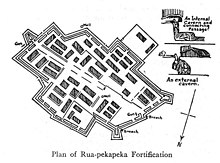
Back Loopgraaf AF حرب الخنادق Arabic Guerra de trincheres AST Пазіцыйная вайна BE Пазыцыйная вайна BE-X-OLD Окопна война Bulgarian Guerra de trinxeres Catalan سەنگەر CKB Zákopová válka Czech Rhyfela mewn ffosydd CY
This article needs additional citations for verification. (December 2022) |



| Part of a series on |
| War (outline) |
|---|
 |
Trench warfare is a type of land warfare using occupied lines largely comprising military trenches, in which combatants are well-protected from the enemy's small arms fire and are substantially sheltered from artillery. It became archetypically associated with World War I (1914–1918), when the Race to the Sea rapidly expanded trench use on the Western Front starting in September 1914.[1]
Trench warfare proliferated when a revolution in firepower was not matched by similar advances in mobility, resulting in a grueling form of warfare in which the defender held the advantage.[2] On the Western Front in 1914–1918, both sides constructed elaborate trench, underground, and dugout systems opposing each other along a front, protected from assault by barbed wire. The area between opposing trench lines (known as "no man's land") was fully exposed to artillery fire from both sides. Attacks, even if successful, often sustained severe casualties.
The development of armoured warfare and combined arms tactics permitted static lines to be bypassed and defeated, leading to the decline of trench warfare after the war. Following World War I, "trench warfare" became a byword for stalemate, attrition, sieges, and futility in conflict.[3]
- ^ Ellis 1977, p. 10.
- ^ Murray, Nicholas (2013). The Rocky Road to the Great War: The Evolution of Trench Warfare to 1914.
- ^ "Trench warfare". Cultural Dictionary. Dictionary.com. Retrieved 14 August 2009.